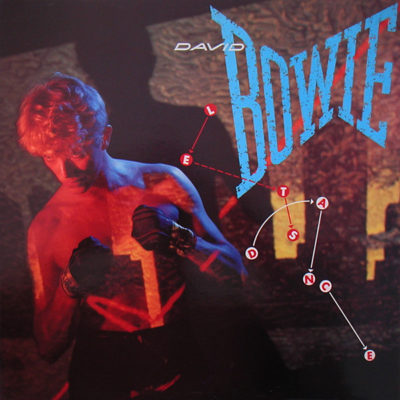“Great” is a landmine in the English lexicon. It means “eminent or important”, but has picked up a secondary meaning of “qualitatively favorable”. Hitler was a great man, and Hitler wasn’t a great man. Both of these statements are true; sometimes important things are not good and vice versa.
Let’s Dance is great. The album broke Bowie in the United States, and it’s clearly one of the most important things he ever did. Soon Bowie would be on the run from its shadow, trying to recreate it and failing (Tonight), then unsuccessfully circling back to what he had before (Tin Machine). But time has diminished Let’s Dance, and made its weaknesses more apparent. You might say it’s dancing on feet of clay.
The songwriting is very smart (absolutely to a fault). The title track opens with harmonised vocals stepping upwards in thirds, a postmodern reference to the Beatles’ “Twist and Shout”. “China Girl” contains a pentatonic major melody that suggests the famous Oriental Riff. Everything’s allusions and callbacks, Bowie trying to fill dance-floors while remaining palatable to theater types.
The production glitters like diamonds. Cubic zirconium, maybe, but for a few minutes you’re having too much fun to notice. Nile Rodgers’ mix is all edge and cut, meant to decapitate dancers through a club PA. A careful listen reveals that the mid-range frequencies are scooped away, turning the album into a flashy but hollow facade. It’s all highs and lows, and lacks substance. There’s little guitar (why pay Stevie Ray Vaughan for his time and then not use him?), and when it appears it sounds thin and weak.
Side A contains all the hits, plus the forgettable “Without You”. Side B is the more uncertain and interesting one. “Richochet” puts its snare on the 1 and 3, giving it a staggered rhythm that sounds “off” even though it’s perfectly on. The lyrics are portentous enough for the drums to sound like bomb blasts, with Bowie’s vocals a robotic call to take shelter. Not a great track, but you finally see some struggle from Bowie, which is a relief on an album as mercilessly polished as an Apple tech demo.
“Cat People” is a remake, “Criminal World” a cover, but both come off fairly well in Nile Rodgers’ hands (although “Cat People” loses its mystery and rushes to the climax too early). “Shake It” is a disposable dance song that pads out the minutes, and then the album’s over. It’s shocking how fast the Let’s Dance ends, and how little music you’ve heard.
There was nowhere to go after Let’s Dance. It annexes itself with sheer power, the way nuclear warfare ends the need to its existence. Let’s Dance is exterior and nothing else: an amazing exterior, nothing really has depth or stays with you. Low grows stronger every time I listen to it, and Let’s Dance grows weaker.
The album is like its production job – a big but empty musical souffle. It was a monster that Bowie never needed to fear: he was better than it, always. Let’s Dance is great album, but I cannot say that it’s a good one.
No Comments »
Oscar Wilde espoused an idea called kaloprosopia, creating oneself as a beautiful character. “Life has been your art. You have set yourself to music. Your days are your sonnets.”
Discussions of who you really were irrelevant to Wilde (and still are, I guess, as he’s dead). People misunderstand everything anyway, so why not be misunderstood as something interesting? Turn yourself into the Taj Mahal, which has so much paint and white marble that nobody can believe there’s plain sandstone underneath.
I don’t know to what extent Bowie liked Wilde. All I know is that he appears on this album’s cover in a dress, and in two more years he’d declare himself gay in the pages of Melody Maker, and twenty years after that he’d declare in Rolling Stone that he was never gay and it was all a publicity stunt, and thirty years after that his former wife Angie would allege to a biographer that she’d caught him in bed with Mick Jagger. Reality? Truth? What’s that?
By 1970, Bowie’s career hadn’t amounted to much. A minor hit with “Space Oddity”, and a follow-up called “The Prettiest Star” which sold 800 copies. Commercial rejection caused him to throw caution to the wind and write some of his most bold and startling material. The Man Who Sold the World is a heavy metal album, recorded several months before Black Sabbath’s Paranoid, an album it nearly matches in riffs and intensity.
Unlike Space Oddity, he had a tight band around him now (an early version of the Spiders, lacking only Trevor Bolder on bass): particularly Mick Ronson, who nearly dominates the album with his guitar work. Tony Visconti was learning a trade at a rapid pace, and his production work almost becomes another instrument.
“Running Gun Blues” was a track Bowie never seemed to keen on performing live after he got famous, for whatever reason (“I’ll slash them cold, I’ll kill them dead! I’ll break them gooks, I’ll crack their heads!”) but it rocks hard and has some strong vocal work. Terrible lyrics aside, it’s a notably early entry in the “crazy Vietnam vet” genre; the album was recorded only a few months after word of the Mai Lai massacre arrived in the United States.
The album doesn’t have one closing song, it somehow has two. “The Man Who Sold the World” is the record’s catchiest cut. “The Supermen” is apocalyptic and Wagnerian, with Bowie shrilling out his lines like an Etonian robot Hitler. Either song would work as an album closer, and it seems only a trick of fate put “The Supermen” last.
But the tracks are like planets orbiting the sun that is “Width of a Circle”, an eight minute epic that predates Ronson’s entrance to the band, although I cannot imagine anyone else playing it. The song is driven by massive riffs, and lead breaks that burn like excoriating fire. Apparently, this became Bowie’s “costume change” song in the Ziggy Stardust era. He’d leave the stage entirely, allowing Ronson to solo over “Width of a Circle” for up to ten minutes!
The lyrics are pretty interesting, fusing the Rolling Stones’ sales pitch for Satanism with homosexual innuendo. I don’t know if the “circle” in the title is a reference to Dante or a something even more nefandous, and that way it will stay. As usual Bowie’s a little cleverer than the Spinal Tappery would suggest: “prayers were small and yellow”…why “yellow”? Cowardice? Or a reference to the yellow book that corrupts Dorian Gray (another Oscar Wilde connection)?
The Man Who Sold the World is full of amazing moments, and it’s a worthy start to a legendary run of albums. Ironically, Bowie himself wasn’t totally on board for it. He’d just gotten married (so the story goes), and beyond a few songs that predated the marriage, his partners in glam had some trouble getting him to write and record. The marriage ended in 1980, but The Man Who Sold the World has lasted and lasted. It’s an enduring classic, and still only his beginning.
No Comments »
My least favorite of the classic DB albums. I don’t like soul music much, and the songs tend to rely upon “call and response” vocal patterns more than actual melodies, which is a shame.
But it’s still special, and contains two of his finest songs. Bowie (at least at this stage of his career) didn’t compromise much: once he picked a style to explore, he carried it through to its conclusion (although whether said conclusion was “The Laughing Gnome” or “Station to Station” depends much on the year and the drugs he was taking). Young Americans represents a total break from the past. It would have bee easy to throw in some riff-driven rockers so the Ziggy Stardust fans have a lifeline, but Bowie rejected any last vestiges of the glam rock that made him famous.
Anyway, amazing song number uno: “Win”. The tone is tender and comforting, propelled by an exposed but deeply affecting vocal performance. I like “Golden Years” a little more, but between the two you have the best work he ever did in this style.
The Beatles cover “Across the Universe” misfires, though considering it also misfired in the Beatles hands, this is probably due to it being a bad song. The “nothing’s gonna change my world…” part remains bewildering: it always makes me think that the singer forgot the vocal melody in front of the microphone and is clumsily ad-libbing a new one.
The song existed as bait to attract John Lennon to the studio, and this gave us the second of Young Americans’ great moments (and a rare #1 hit): “Fame”. The song opens with brass playing a pair of 3/4 bars. The melodies seem to bloom in the air like flowers: their promise false.
The rest of the song is jittery and claustrophobic, consisting of yelped vocals over a sparse rhythm section. Carlos Alomar’s guitar riff is fascinating, jabbing you so quickly and sharply that it seems to penetrate vital organs. If “Fame” was a painting, it would be pointillism. Lennon’s guest contribution is to double the vocals – hitting you with David’s lyrics in stereo.
The rest of the album does the job to varying degrees. The title track (as with the album before it) ends up being kind of a non-event. It sets the tone, but doesn’t really. I quite enjoy “Fascination”, although I miss the heavy riffs and melodic singing.
One dud. Two amazing songs. Bowie would find that America aged him pretty fast, at this stage of his career he produced exceptional work wherever he lived and worked. A pretty amazing accomplishment: we’re watching Bowie jump into empty space…and land on his feet.
No Comments »



